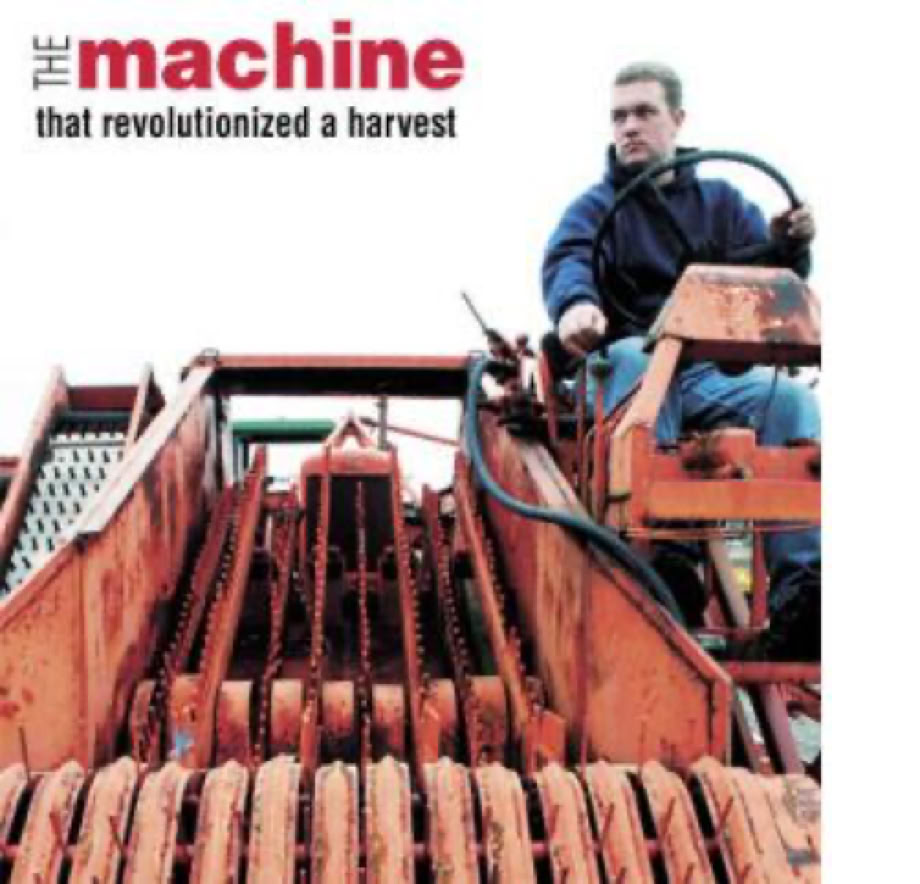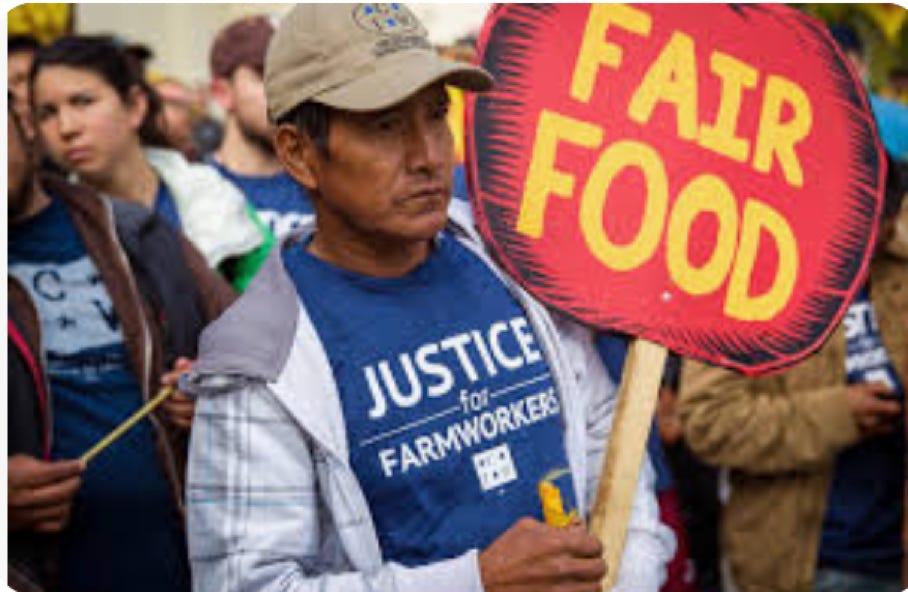

Always the low wage!
Most USA processed tomato products come from California. The green as Kermit tomatoes are harvested while still brick hard by machine. Once upon a time the thought of mechanically harvesting tomatoes seemed ridiculous to most reasoning folk. But not to University of California's crop researcher Gordie "Jack" C. Hanna. Much to his colleague's dismay, in 1942 Gordie began his search for the tomato that could stand up to the rigors of machine harvest. Although his friends warned him he could ruin UC's reputation through such a Quixotic venture, Gordie insisted on walking tomato fields and tossing tomatoes on to the road. Those that didn't smash or crack were selected for his breeding program. In 1949 Gordie began collaborating with UC's agricultural engineer Coby Lorenzen to develop a mechanical tomato harvester.
By 1962 both projects had succeeded. Hanna, after experimenting with over 2000 cultivars, had his VF-145 tomato which instantly became dubbed 'the square tomato'. The VF-145 was firm, the fruits easily detached from the vine, and most ripened at the same time. Meanwhile Lorenzen had his harvester ready for farm machinery builder Ernest Blackwelder to manufacture.The new invention cut the plants off at ground level, separated the fruits from the vine, discarded the vine, and pitched the tomatoes into a gondola truck to be hauled to market. This new approach to tomato-culture was adopted quickly by the farm community. In 1964 only 25% of California's tomato crop was machine harvested. By 1970 almost 100% of the tomatoes were.
But the machine has yet to be invented that won't bruise a tomato in the ripening stage that's to be eaten fresh. Florida is the U.S. leader in fresh-market tomatoes. Only a few years ago Bonita Springs was rightly hailed as the "Tomato Capital of the World." Tomatoes grown on 4,000 acres of swampland were a multi-million dollar business with over 225,000 tons shipped annually. Now most of that land has been converted to golf courses, gated communities, and strip malls. But the tomato farms did not vanish into thin air, they've only moved farther into the Everglades. The US Ag. Dept. records show a million acres in Lee, Collier, Hendry, and Glade counties devoted to agriculture. And although farming added $1.2 billion dollars to the regions economy in 2007, in the immortal words of Kermit, "It ain't easy being green."
Real Estate sales driving up land prices are not the only hurdle tomato growers face. The North American Free Trade Agreement allowed cheap imported tomatoes to flood the US market. Since NAFTA was signed in 1994 a fourth of Florida's largest growers have dropped out of the business while the number of packing houses is half the pre-NAFTA number. Before NAFTA Miami-Dade dedicated 13,000 acres to tomatoes. Since the agreement only 3000 remain. In the same period Mexico has increased its tomato exports from 350,000 tons to 850,000.
First organized in 1993 and growing to 3000 members, the Coalition of Immokalee Workers brought worldwide attention to slavery and human rights abuses happening in the fields of South Florida. Having made progress with their employers, the coalition in 2001 targeted one of the major buyers, Taco Bell. Demonstrations, boycotts, hunger strikes, and international media attention led to Taco Bell agreeing to all of CIW's demands and the formation of a new activist group, the Alliance for Fair Food. With victory under their belt, CIW and AFF took on McDonalds and in 2007 reached an agreement even more generous and broader in scope. Picking off franchises one at a time, the Campaign for Fair Food still continues.
Mexico competes directly with the Florida tomato industry by exporting nearly $2 billion worth of fresh-market tomatoes into the USA annually. Florida producers complained bitterly to get out of a 1996 trade agreement with Mexico that they insisted allowed Mexico to dump tomatoes into the USA below production costs.
The Mexican growers, who more and more have shifted to covered crops and greenhouse techniques, argued that Florida growers real problem is that they simply have refused to stay abreast of modern technology. United States and Mexican negotiators came to an agreement March 4, 2012, that more than doubled the reference price of Mexican tomato imports. Angry Mexican growers and elected officials surmised that the agreement was solely designed to help President Obama carry Florida in the 2012 election against contender Mitt Romney.
Walmart along with over 300 other US businesses had representatives who argued in favor of maintaining Mexico's lower prices, but no doubt, Valentin Hernandez was not asked for his opinion. As bad as conditions are for Florida tomato harvesters, labor practices are even worse south of the border. Valentin unfortunately answered a radio ad that promised room, board, and work for his family. But conditions at the labor camp in Toliman were not what he expected. Their personal belongings were confiscated and Valentin and his family were made to share a tiny room with two other families. The pay was less than half of what had been advertised, and most of it was in the form of vouchers only redeemable at the company store. Workers who tried to escape these deplorable conditions were captured and beaten.
You would hope tomato pickers north of the border were getting a better deal, but in 2011 Canada's Supreme Court sided with Ontario's provincial government denying farm workers the right to unionization and collective bargaining. Canada has felt the effects of the glut of Mexican tomatoes into the US. Imports from Canada's hothouse tomato industry that peaked in 2005 have declined with the rising competition from Mexico. Due in part to Mexico's heavy investment in high-tech agriculture and low labor costs, Mexico now accounts for 71 percent of the U.S. import market for greenhouse tomatoes, while Canada's share has been reduced by half to 27 percent.
Leamington, Ontario,Canada's tomato capital, boasts having Canada's best climate. Not exactly Miami, FLA, yet it definitely reigns as Canada's most productive area for fruit and vegetables. While field tomatoes are grown on over 6000 acres, Leamington, with over 5.5 million square meters under glass, has more greenhouse space than the whole USA. Row crops supply a local Heinz processing plant and field grown and greenhouse vine-ripe tomatoes are shipped to supermarkets across the USA as well as Canada. Greenhouse tomatoes are available March through November.The hothouse, handpicked beefsteak, cluster, roma, and cherry tomatoes have a perfect appearance and are very flavorful. Probably no one would mistake a Canadian greenhouse tomato for a late summer Brandywine freshly plucked from the backyard garden, but fine chefs and discriminating shoppers alike willingly pay a premium for Leamington 's vine-ripes when home-growns are unavailable.
China is moving quickly into the processed tomato products market. Most consumers would probably not be aware of the Chinese imports because food labeling does not show that even though the end product was manufactured locally, the actual ingredients are foreign. The tomato industry barely existed in China 10 years ago. Now it surpasses California in total production. Consumers should rightly be worried about Chinese lax enforcement of health and safety measures. Recent discoveries of carcinogens in Chinese chili paste have not helped. Equally troublesome is China notorious disregard for worker rights. $9 dollars a day is the typical pay for Chinese labor. But illegal immigrants from Southeast Asia, North Korea, and Africa who work at even lower wages are smuggled into China regularly by coyotes being paid $30 per head.
Yet it gets even worse. China is forcing Uyghur Moslems into slave labor camps in a systematic process aimed at dehumanizing and destroying an entire population.






